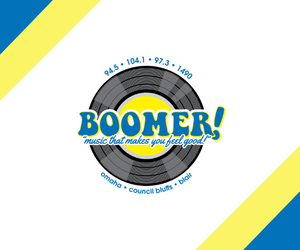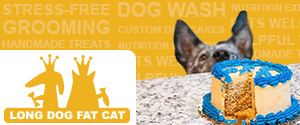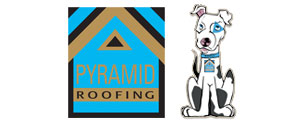- Do you subscribe to Dharma Dog Training’s Newsletter? You should.
- A Unique Campaign from The Humane Society of the United States
- Rabid bats in Omaha- Stay safe, prepared with these tips
- Springtime Activities in Omaha
- Mill Dog Monthly from Bailing Out Benji
- World Spay Day, Legislative Alert in Nebraska
- Attend the Nebraska Rescue Council’s monthly meeting this Saturday
- Five Hard-to-Ignore Reasons to Adopt!
- Paws in Pink to Benefit Breast Cancer Foundation
- VCA, Inc. Acquires MidWest Vet Specialists from Kansas State University
Got an anxious dog? Here’s a guide to understanding, helping your pup

A common problem with dogs, especially those who are new to a family and fresh out of a shelter/rescue situation, is anxiety. Whether it’s separation from a pup’s owner or home, getting settled during an atypical day at home, or something else, it’s nice to be armed with information that you can use to help your anxious pup. Below, find a guide to dealing with an anxious pup, thanks to Warren Fowler, the latest contributor to Pets in Omaha.
The Definitive Guide to Dealing with an Anxious Dog
Owning a dog is a challenge in and of itself, but owning an anxious dog is a whole other level of challenge. You’ll see your pet trembling, whining, drooling, or panting. You do your best to comfort him, but nothing works.
Just like people, dogs get anxious when facing their biggest fears. The problem is that they cannot talk, so they can’t tell us what’s troubling them. As an owner, you have a responsibility to recognize the symptoms of anxiety in your dog and help him go through the situation, bringing him back to the happy and careless state of being that you’d love to see.
First: Understand Why Dogs Get Anxious
Before you start wondering how you can help your dog get over anxiety, it’s important to know about its sources. There are few common anxieties in dogs:
- Separation Anxiety
This is one of the most common types of stress that dogs suffer from. They are so attached to their owners that they get destructive when being left alone. They will pee and poop all over the place. They will chew on things they shouldn’t chew on. They will bark without stopping. Most of everything, they will do their best to escape.
Sometimes the symptoms of separation anxiety are not that drastic.
Danny Adams, a writer for BestEssays, shares a rather interesting experience: “Since I work from home, my dog was used to being by my side all the time. When I went on vacation, I left her at my sister’s house. She was sad but behaved well. The troubles started when I got back. She was so scared that I would leave her again that she was howling whenever I went to the bathroom. One day I went to the store and got back home in 10 minutes, only to find my (very expensive!) carpet destroyed.”
This type of anxiety is based on the fear of being left alone. The dog doesn’t know that you’re away for an hour, a day or a week. For him, you went away, and that’s a total tragedy.
- Travel Anxiety
Some dogs are afraid of car rides. They tremble all the time, they pee, and they even vomit.
- Noise Anxiety
Is your dog’s anxious behavior triggered by fireworks, thunder, or the vacuum cleaner? Then we’re talking about noise anxiety.
- Containment Anxiety
Your dog can’t stand being in a crate? You can’t get him home after a walk? He goes crazy even when he’s in a small backyard? This is one of the most challenging types of anxieties in dogs, especially if you plan to keep them in an apartment. When dogs are afraid of containment, they will continuously try to escape.
Recognize the Symptoms
You’ll quickly notice when your dog is unusually excited. That state may go away as soon as you locate and remove the reason of fear. If, for example, your dog barks at the vacuum cleaner, he’ll calm down when you turn it off. But if the symptoms are persistent and you notice that the dog is unhappy, we’re talking about real anxiety.
Briefly, here are the main symptoms to keep an eye on:
- Whining
- Hiding
- Elevated heartbeat
- Holding the tail between the legs
- Trembling or shivering
- Vomiting
- Barking
- Excessive grooming
- Too much energy
- Destructive behavior
- Scratching dogs or digging under them
- Aggressive behavior
If any of these symptoms are more noticeable than usual, then your dog is anxious. You have to stay calm. It’s not your dog’s fault. With proper techniques and support, you’ll help him overcome the fears.
How to Help a Dog with Anxiety
1. Never Punish Your Dog for Being Afraid
We can’t stress this enough. It’s not your dog’s fault! Maybe he scratched the door, but that’s because he was too afraid and anxious after you left him alone. Perhaps he vomited in your car, but that’s because you just faced him with his biggest fear.
Anxiety is the body’s reaction to chemical processes in the brain. Raising your voice or (God forbid!) hitting the dog would only make the situation worse.
2. Don’t Leave the Dog Alone for Too Long
Dogs are social animals. They seek human company, and they get stressed when you leave them alone. Needless to say, sometimes it’s necessary to leave the dog alone. But how much time is too much?
A survey of British dog owners found that most of them believed it was okay to leave the dog alone at home for 6-10 hours per day. But even that may be too much for a puppy who’s not used to the idea and feeling of being alone.
If you absolutely need to leave your home for hours and you know that he gets anxious when you leave, consider hiring a dog walker or sitter. You may even take the dog to daycare.
3. Behave Normally
You’re about to leave home, and your dog starts whining. There’s a thunderstorm, and your dog gets frightened. You’re about to put him in the car, and he shows his anxious behavior.
Your initial reaction would be to coddle or pet the dog. You believe that would calm him down. You’re wrong!
When you pet the dog when he’s panicked, he gets the affirmation that something scary is happening. He believes there’s really something to be afraid of.
Instead of petting or coddling your dog, just act normal. Act as you don’t pay attention to the scary thing.
You may come up with a distraction, such as a toy or a bone he can chew on. Whatever you do, don’t support the dog’s anxious reaction by hugging or petting him.
Hey; you’ll get through this. You both will! As an owner, you have a lot to learn about your dog, and this is just the start. The good news is that it’s a beautiful process that brings the two of you closer together.
Short bio:
Warren’s lifestyle is full of hiking adventures. When he’s not busy with his guitar or enjoying the sunny day outside, he excels at blogging skills and scrolls through social media. You can meet him on Twitter and Facebook.
Related Posts
Latest News
-
Choosing the Right Pet for Your Lifestyle
Are you thinking about getting a pet but unsure what...
- Posted 6 days ago
- 0
-
How to Make Your Rescue Pet as Comfortable as Possible
Did you bring home a new pet from a shelter...
- Posted 4 weeks ago
- 0
-
How Having A Pet Can Change Your Life
Having a pet can open your heart in ways that...
- Posted 6 months ago
- 0
-
How To Improve The Life Of Your Senior Pet
Do you have an elderly fur baby and want to...
- Posted 7 months ago
- 0
-
Springtime Activities To Enjoy With Your Furry Friends
Are you preparing for warmer weather and want some ideas...
- Posted 8 months ago
- 0
-
Pros And Cons Of Microchipping Your Pets
Have you considered whether your pets should be microchipped and...
- Posted 8 months ago
- 0
-
The Best New Fun Toys For Dogs And Cats
The Best New Fun Toys For Dogs And Cats Did...
- Posted 9 months ago
- 0






















You must be logged in to post a comment Login